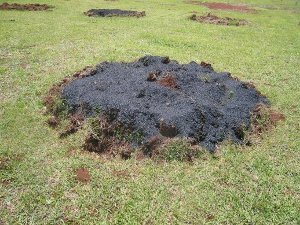
Pacific Pyrolysis Demonstration Facility
|
Name of Biochar Project: Pacific Pyrolysis - Pyrolysis Demonstration Facility Research Institution / Department / Company: Pacific Pyrolysis Project Funding Acknowledgment: Pacific Pyrolysis, NSW Department of Environment and Climate Change |
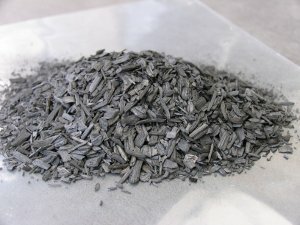 Research Team: Adriana Downie, Technical Manager Peter Klatt, Engineering Manager Warren Scott, Workshop Manager Pacific Pyrolysis Engineering, Workshop and Business Management team. |
|
Abstract of Project/Research: Pacific Pyrolysis has a fully integrated continuous slow pyrolysis pilot plant at Somersby NSW. This facility has successfully converted a range of organic feedstocks, including animal manures, crop and foresty residues, council greenwaste etc, into biochar and green electricity. The pilot plant is considered a 1/10th commercial scale demonstration and has allowed Pacific Pyrolysis (previously BEST Energies Australia) to develop the verified process modelling and operational experience required to provide technology for this emerging industry. |
 Preliminary Results/Key Findings: Pacific Pyrolysis has utilised the AgricharTM biochar product produced from the pilot plant to supply researchers in Australia, New Zealand and Internationally. The availability of this material, made from well characterised feedstocks under known process conditions has enabled rigourous and reproducible research to be conducted. Preliminary Results/Key Findings: Pacific Pyrolysis has utilised the AgricharTM biochar product produced from the pilot plant to supply researchers in Australia, New Zealand and Internationally. The availability of this material, made from well characterised feedstocks under known process conditions has enabled rigourous and reproducible research to be conducted. The success of the pilot plant has enabled Pacific Pyrolysis to scale up to commercial scale pyrolysis plants with confidence. Currently designs for two scales of commercial biochar production facilities are available. Pacific Pyrolysis is working with industry partners to implement the technology on a commercial scale. |
Biochar for Tasmanian Eucalyptus Forestry Plantations
Name of Biochar Project: Biochar as a soil amendment and growth stimulus for Eucalyptus forestry plantations under Tasmanian conditions.
Research Institution Department/Company: University of Tasmania, School of Engineering, School of Agricultural Science.
Project Schedule: Commenced 2011 - Planned Completion 2014
Research Team:
Dr Jane Sargison (UTAS/Project Rainbow Bee Eater)
Dr Mark Boersma (UTAS)
Dr Dugald Close (UTAS)
Dr Evelyn Krull (CSIRO)
Ms Anna Wrobel-Tobiszewska (UTAS)
Abstract of Project/Research:
The Project is aimed at investigating the effects of biochar on the soil changes and plants growth, focusing on forestry species. The analysis will be carried on young seedlings of Eucalyptus nitens to provide sufficient knowledge of interactions between biochar, fertilizer, soil condition, yield and establishment conditions of Eucalyptus plantations for commercial use.
The two phase approach will cover different growth stages of Eucalypt 1) From seeds to young seedlings under glasshouse conditions, 2) Early growth of seedlings under field conditions.
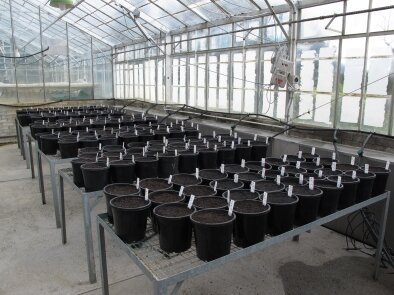
The analysis will include soil chemistry, plants performance, soil solution changes and plant nutrients uptake under different fertilizer and Biochar amendments.
The results of the project are expected to provide knowledge concerning usefulness of Biochar amendments to commercial forestry plantations regarding possibility to decrease fertilizer inputs and lower the overall costs of plantation establishment as well as widen general knowledge about the agronomic response of forestry species to Biochar amendment.
As biochar may be produced from any biomass waste it is likely that its production from forestry waste will provide the industry with environmentally-friendly solutions to improve the soil quality and manage waste in a more sustainable way.
The results of the study are expected to allow modeling the growth of Eucalyptus under changing water and nutrient conditions with biochar application.
Preliminary Results/Findings: Eucalyptus nitens agronomic response to different biochar doses under various fertilization treatments. Recommendations for commercial use of biochar for forestry industry.
Biochar: Produced by Rainbow Bee Eater Pty Ltd from Macadamia shells
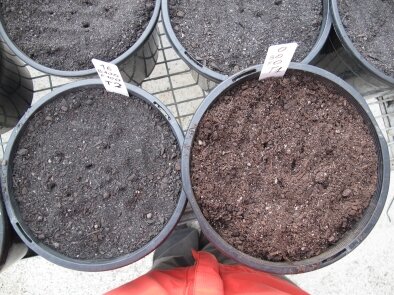
Biosolids Reuse Trial for Production of Biochar and Energy
|
Name of Biochar Project: Biosolids Reuse Trial for Production of Biochar and Energy Research Institution/Department/Company: Wannon Region Water Corporation / Real Power Systems / Glenelg Hopkins CMA Project Funding Acknowledgment: Smart Water Fund Project Schedule: Commenced 01/05/10 - Planned Completion 30/06/11 |
|
Research Team: Real Power Systems |
|
Abstract of Project/Research: The overall purpose of this study is to test the commercial potential of producing biochar using pyrolysis and its potential for use in the agricultural industry in Southwest Victoria. The challenge is to convert a waste resource, namely biosolids to a stable long-lived biochar which could be used as a soil amendment to benefit agriculture, forestry and revegetation and to derive sufficiently combustible syngas from the process with potential to produce renewable energy. Preliminary Results and Findings Test data and calculated results derived from the trials using the 1:2 blend of sludge to wood chip shows that a single standard RPS model using thei blend, and operating full time could expect to generate: - 50kWe/hr or 387 MW for a full year; - Produce 306 tonnes of biochar; - Consume 1724 tonnes of fuel with similar charecteristics to the test sample; and - 770 tonnes would consist of bio-solids and 954 tonnes of wood chip. |
|
Biochar: Made from boisolids and woody waste sourced from the Hamilton Water Reclamation Plant |
Biochar for Orchards Soil Carbon Management
|
Name of Biochar Project: Biochar for improved orchard soil carbon management Research Institution/Department/Company: University of Tasmania (UTAS) / Tasmanian Institute of Agricultural Research (TIAR) Project Funding Acknowledgment:Tasmanian Institute of Agricultural Research (TIAR), Univesity of Tasmania, Pacific Pyrolysis, Tahune Fields Nursery Project Schedule: Commenced 04/07/09 - Planned Completion 03/07/10 |
|
Research Team: Tom Street (UTAS) Dugald Close (UTAS/TIAR) Richard Doyle (UTAS |
|
Abstract of Project/Research: A pot trail was conducted to investigate the effects of biochar on the growth and nutrition of young apple trees under a range of nutrient and moisture conditions. Herbiciding of tree rows to reduce understory competition with trees is common practice in conventional orchards in Australia and New Zealand. This leads to declines in soil organic matter and soil health. Biochar may be able to ameliorate these health declines in a similar way to uncharred organic matter through improving soil physical properties and increased nutrient retention. Below: Root Stock at 8 Weeks |
|
Biochar: Greenwaste derived biochar supplied by Pacific Pyrolysis. |
Biochar and Compost in Orchards
|
Name of Biochar Project: Interaction of bichar and compost in an orchard soil Research Institution/Department/Company: Tasmanian Institute of Agricultural Research, University of Tasmania Project Funding Acknowledgment: Horticulture Australia Limited; University of Tasmania Project Schedule: Commenced 01/11/09 - Planned Completion 31/05/14 |
|
Research Team: Dr Sally Bound, TIAR, University of Tasmania Dr Dugald Close, TIAR, University of Tasmania Dr Brent Clothier, Plant & Food Research, New Zealand Dr Markus Deurer, Plant & Food Research, New Zealand |
|
Abstract of Project/Research: As part of the National Apple & Pear Productivity, Irrigation, Pests and Soils (PIPS) program, a replicated field trial was established in November 2009 on a new planting of Fuji apple trees in a replant site in the Huon Valley, Tasmania to investigate the effects of biochar and compost on soil physical and chemical properties, soil functioning, tree growth and fruit quality. Biochar, compost and a combination of biochar plus compost will be compared with an untreated control. Parameters to be studied over the life of the project include tree growth measurements, changes in soil physical and chemical properties and in soil fauna, and fruit yield and quality. In addition, flux meters will be installed to determine soil’s ability to buffer and filter water and nutrients as a function of soil carbon. |
|
Biochar: Greenwaste derived biochar supplied by Pacific Pyrolysis. |
Biochar for the Grains Industry
|
Name of Biochar Project: A fundamental understanding of biochar - implications for the grains industry Research Institution/Department/Company: CSIRO Land and Water, University of Western Australia Project Funding Acknowledgment: GRDC, CSIRO, Univ WA Project Schedule: Commenced 30/06/09 - Planned Completion 30/06/12 |
|
Research Team: Evelyn Krull, CSIRO; Rai Kookana, CSIRO; Thomas Kuhn, CSIRO; Lynne MacDonald, CSIRO; Ron Smernik, Adelaide Uni; Anna McBeath, Adelaide Uni; Dan Murphy, UWA; Dan Dempster, UWA; Zakaria Solaiman, UWA; Noraini Jaafar, UWA; Louise Barton, UWA; Paul Blackwell, DAFWA; Fran Hoyle, DAFWA; Louise Barton, UWA |
|
Abstract of Project/Research: To evaluate the potential of biochar to improve the long-term profitability of growing broad-acre rain fed crops on low fertility coarse textured soils. Such soils are prone to nutrient leaching losses from soil organic matter decomposition and fertiliser application. The potential capacity fo biochar and associated soil biology to adsorb/immobilise plant nutrients and slowly release them could minimise nutrient losses (both leaching and gaseous emissions). In the first year, the project will commence with the identification of appropriate feedstocks and production methods for biochar generation. A set of biochars will be produced and analysed comprehensively for their chemical properties. Based on these data, a number of biochars will be selected for detailed field and laboratory-based experiments to assess the different aspects of the biochar on crop nutrition and associated soil properties. |
|
Biochar: Biochars from wheat, oil mallee, chicken manure, wood waste, and biowaste, will be produced via slow pyrolysis at 450 and 550oC. |
From Source to Sink
|
Name of Biochar Project: From source to sink: A national initiative of biochar research Research Institution/Department/Company: CSIRO Land and Water (lead organisation) Project Funding Acknowledgment: DAFF, CSIRO, Univ WA, UNE, UNSW, NSW DII, Univ Sydney, Univ Adelaide, Pacific Pyrolysis, Anthroterra Project Schedule: Commenced 30/10/09 - Planned Completion 30/05/12 |
|
Research Team: Evelyn Krull, CSIRO (project leader); Annette Cowie, UNE; Lukas van Zwieten, NSW DII; Deborah O'Connell, CSIRO; Rai Kookana, CSIRO; Mark Farrell, CSIRO; Bhupinderpal Singh, NSW DII; Balwant Singh, USyd; Dan Murphy, UWA; Paul Blackwell, DAFWA; Adriana Downie, Pacific Pyrolysis/UNSW; Stephen Joseph, Anthroterra/UNSW; Greg Butler, SANTFA |
|
Abstract of Project/Research: This project will draw together leading researchers in Australia in the areas of biochar, bioenergy, soil science, emissions management and life-cycle assessment into a national effort, aimed to address key aspects of biochar generation and application in Australian agriculture. Research objectives are grouped in three broad categories which are closely linked with each other and which will focus on identical materials and standardised measurements: Biochar-soil interactions; Biochar and GHG mitigation; Biochar/bioenergy production and life-cycle assessment |
|
Biochar: Over 40 feedstocks at different temperatures will be investigated under different process regimes; mostly slow pyrolysis. |
NSW DPI - Reduction in N2O Emmissions
|
Name of Biochar Project: Reduction in N2O emmissions from soils ammended with Biochar Research Institution/Department/Company: NSW Department of Primary Industries Project Funding Acknowledgment: NSW Department of Primary Industries, NSW Department of Environment and Climate Change and Pacific Pyrolysis. 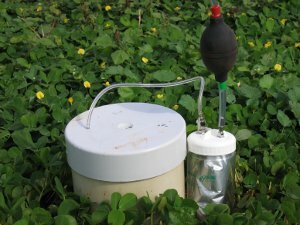 Project Schedule: Commenced 2007 - Completed 2009 Project Schedule: Commenced 2007 - Completed 2009 Research Team: Dr Lukas Van Zwieten, NSW Department of Primary Industries Mr Stephen Kimber, NSW Department of Primary Industries Ms Elspeth Berger, NSW Department of Primary Industries Mr Josh Rust, NSW Department of Primary Industries Mr Scott Petty, NSW Department of Primary Industries |
|
Abstract of Project/Research: Seven chars produced from feedstocks including papermill waste (1), poultry litter (2) and greenwaste (4) were incubated with a red ferrosol soil under co Overall emissions however clearly showed that nitrous oxide was more significant than emissions of carbon dioxide, due to the multiplying factor used for nitrous oxide (310). The greenwaste chars were less effective in reducing nitrous oxide emission. analyses are carried out under ISO9001:2000 accreditation. Greenhouse gas analysis was conducted on a dedicated, multi-channel analyser, capable of simultaneous analysis of nitrous oxide, methane, carbon dioxide and carbon monoxide. Biochar: Pacific Pyrolysis AgricharTM biochars from the slow pyrolysis of Australia papermill wastes, Council Greenwaste and poultry litter. |
| Preliminary Results/Key Findings: Reductions in N2O emissions |
|
Publications, conference slides/abstracts, media coverage etc: IBI 2008, Newcastle UK, Sept 7-10, 2008 S. Kimber: Biochar has potential to reduce greenhouse gas emissions |
NSW DPI - Sugarcane Trials
|
Name of Biochar Project: Assessment of Biochar in Sugarcane cropping systems Research Institution/Department/Company: NSW Department of Primary Industries Project Funding Acknowledgment: National Landcare Program, NSW Department of Primary Industries, Pacific Pyrolysis and Richmond Landcare Project Schedule: Commenced 2007 - completed 2008 |
|
Research Team: Dr Lukas Van Zwieten, NSW Department of Primary Industries
Dr Yin Chan, NSW Department of Primary Industries Dr Annette Cowie, NSW Department of Primary Industries Ms Adriana Downie, Pacific Pyrolysis Mr Robert Quirk, Richmond Landcare Mr Tony Walker, Richmond Landcare Mr Josh Rust, NSW Department of Primary IndustriesMr Scott Petty, NSW Department of Primary Industries |
|
Abstract of Project/Research: Field trial was established in 2007 in a commercial sugarcane crop in the Tweed valley, northern NSW. A total of 15 plots (30m plot length x 3 rows of cane -per plot) were set up using BioPy thermokinetic Biochar: Pacific Pyrolysis AgricharTM Biochar, Slow Pyrolysis, Australia papermill wastes and Council Greenwaste. |
| Preliminary Results/Key Findings: Reductions in N2O emissions and Increases in soil C. |
| Publications, conference slides/abstracts, media coverage etc: Poster at Newcastle UK, demonstrating work on N2O. |
NSW DPI - Papermill Biochar
|
Name of Biochar Project: Benefits of papermill biochar Research Institution/Department/Company: NSW Department of Primary Industries Project Funding Acknowledgment: Renewed Fuels, NSW Department of Primary Industries and Pacific Pyrolysis. Project Schedule: Commenced 2007 - Completed 2008 Research Team: Dr Lukas Van Zwieten, NSW Department of Primary Industries, Mr Stephen Kimber, NSW Department of Primary Industries, Dr Yin Chan, NSW Department of Primary Industries, Dr Annette Cowie, NSW Department of Primary Industries, Ms Adriana Downie, Pacific Pyrolysis, Prof Stephen Joseph, University of NSW, Mr Josh Rust, NSW Department of Primary Industries, |
|
Abstract of Project/Research: This project assessed the characteristics of biochar derived from papermill waste, and the agronomic and potential environmental benefits from applying this biochar to agricultural soils. Biochar was produced using slow pyrolysis of enhanced solids reduction sludge, clarifier sludge and waste wood chip from an Australian papermill. The structure of the biochars was highly heterogeneous with a large degree of macro-porosity around 1 to 10 microns. The surface area of the feedstock was increased 50-fold through slow pyrolysis. The biochar had liming values of ca. 30% CaCO3, and carbon contents ca. 50% Calcium mineral agglomerates, detected by scanning electron microscopy (SEM) and energy-dispersive X-ray (EDS), account for the liming effect. Biochar was applied at 10 T ha-1 to two soil types, an acidic red ferrosol and an alkaline calcarosol. The impact of biochar with and without a complete fertiliser was tested in factorial combination. Benefits to soil properties included increased pH in the ferrosol of up to 2 units, significantly increased total soil carbon (between 0.5% and 1%) in both soil types, increased CEC in the ferrosol, and reduced Al availability (from 2cmol (+) kg-1 to <0.1 cmol (+) kg-1). The biochars significantly increased crop growth (measured as height and weight of plants) in the ferrosol: wheat biomass was up to 2.5 times higher when biochar plus fertiliser was compared to fertiliser treatment alone. Results suggest improved fertiliser use efficiency with biochar application, especially in the ferrosol. Earthworms showed preference for biochar-amended soil over control soils. This was particularly evident in the ferrosol where up to 92% of the worms migrated to the biochar-amended soil. The results from this work demonstrate that biochars derived from papermill wastes are valuable soil amendments. This work is currently under review for publication in an international journal. Current work on papermill biochar is investigating its impact on nutrient cycling in soil, and testing for its capacity to reduce emissions of the potent greenhouse gas nitrous oxide from soil. Biochar: Pacific Pyrolysis AgricharTM Biochar made from Autralian Papermill wastes via slow pyrolysis. |
|
Preliminary Results/Key Findings: Benefits to CEC, reductions in N2O emissions, pH modification due to Ca mineral agglomeration, earthworm and soil micro-organism friendly, waste solution. |
|
Publications, conference slides/abstracts, media coverage etc: Currently under review for international publication. Presented at the 2007 International Biochar Initiative Conference, Terrigal, NSW, Australia |
ANU/CSIRO - The CharXive Challenge
|
Name of Biochar Project: The CharXive Challenge. Research Institution/Department/Company: The Australian National University and CSIRO. Project Funding Acknowledgment: ARC Future Fellowship FT0991007 |
|
Project Schedule: Commenced 15/03/2010 - Planned Completion 15/03/2014 Research Team: Dr Rowena Ball. website: www.maths.anu.edu.au/~ball/ email: " |
|
Abstract of Project/Research: Conversion of waste biomass to biochar has been advocated as a method of sequestering atmospheric CO2 and methane. Vegetation fires also produce biochar but it is an open question as to how much atmospheric greenhouse gas (GHG) is sequestered globally by vegetation fires.In this project I conceptualise the question as an important aspect of the general CharΧive Challenge, which deals with the scientific and socioeconomic questions associated with increasing the refractory biochar pool at the expense of the atmospheric carbon pool given that the only way into the biochar pool is through thermoconversion of biomass. |
|
Preliminary Results/Key Findings: * We have reviewed the thermoconversion chemistry of cellulosic biomass interpretively. Competitive thermal degradation to char and volatiles is the crucial process that affects the spread of and char production from open vegetation fires. * The mechanisms of aromatisation during char formation have long been an open research problem. We have deduceded a reasonable, energetically favourable and well-founded mechanism based on a Diels- Alder condensation between a conjugated unsaturated aldehyde and a decarbonylated diene species, that also results in crosslinking of the dehydrated thermolysed cellulose fragments. * Biomass fires open a ‘hatch’ that pours carbon into the long-term global reservoir of refractory black carbon (BC). This is a sink for atmospheric CO2 if the rate of BC production (or dimension of the hatch) is greater than the rate of BC decay. * The hatch mechanism is the BioPy thermokinetic oscillator, a special case of an Endex thermoreactive system, which is effectively short-circuited when wildfires are suppressed. * The first CharΧive Challenge asks the question: Can we make enough biochar to stabilise the climate in the short-term, without adding to environmental problems? * The second CharΧive Challenge asks whether we have painted ourselves into a corner; it asks whether nature’s use of fire to distribute carbon between long-term black carbon and short-term atmospheric pools is fundamentally incompatible with humans’ need to suppress fire. * The third CharΧive Challenge is the most important. Schemes to geoengineer the earth such as making and distributing biochar on a global scale could backfire (as it were) disastrously unless we first obtain accurate quantitative (how much?) and qualitative (what are the rate functions and nonlinearities?) research data on the amount of carbon in the global black carbon reservoir, biochar production rates, and black carbon oxidation rates in different environments. Then may we begin to make progress on designing and implementing scientifically sound, socioeconomically benign global carbon management. 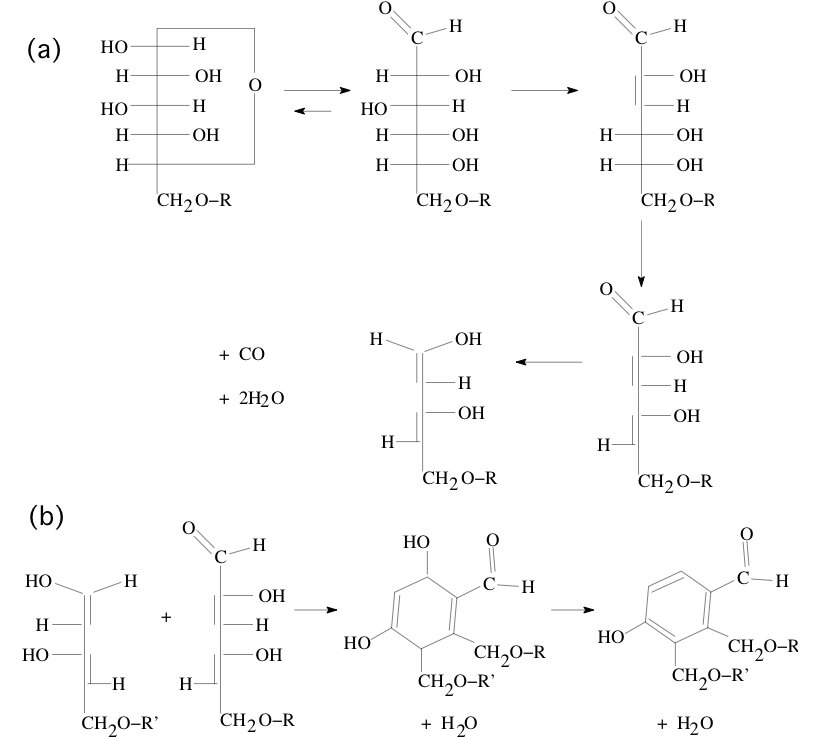 Some of the chemical reactions that a thermolysed cellulose fragment may undergo en route to char formation (diagram courtesy of Dr Rowena Ball). (a) The hemiacetal and aldehyde groups on a hydrolysed end exist in an equilibrium that may favour the open-ring aldehyde as heat and acid catalysis drive dehydrations to a conjugate species. (b) A Diels-Alder condensation between a conjugated unsaturated aldehyde and a decarbonylated diene species is an energetically favourable route to interchain linking and aromatisation. |
|
Publications, conference slides/abstracts, media coverage etc: News stories on aspects of this research have been published by the Institute of Physics at http://environmentalresearchweb.org/cws/article/futures/34224, and MIT Technology Review at http://www.technologyreview.com/blog/arxiv/25383/. Publications have been submitted to refereed journals. |
NSW DPI - National Landcare Trials
Name of Biochar Project: Soil carbon sequestration and rehabilitation: Landholders develop, implement and assess biochar.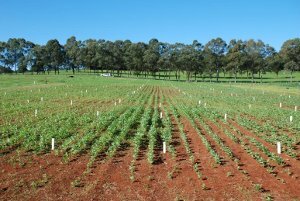 Research Institution / Department / Company: NSW Department of Primary Industries Project Funding Acknowledgment: National Landcare Program-Sustainable Practices Grant, NSW Department of Primary Industries, Pacific Pyrolysis and Richmond Landcare Project Schedule: Commenced 2008 - Planned Completion 2011 |
|
Research Team: Dr Lukas Van Zwieten, NSW Department of Primary Industries,
Dr Yin Chan, NSW Department of Primary Industries, Dr Annette Cowie, NSW Department of Primary Industries, Ms Adriana Downie, Pacific Pyrolysis Mr Robert Quirk, Richmond Landcare Mr Tony Walker, Richmond Landcare Mr Josh Rust, NSW Department of Primary Industries |
|
Abstract of Project/Research: There is growing interest worldwide in the use of biochar as a soil amendment. It has the potential to both sequester C and enhance agricultural productivity. It holds particular significance for its potential to rehabilitate degraded soils. In work undertaken by NSW DPI, biochar significantly improved plant growth. It increased pH in acidic soils, improved water holding characteristics, reduced tensile strength of soil and improved nutrient availability (Chan, Van Zwieten et al., 2007; Chan, Van Zwieten et al 2008). The recalcitrant nature of C in biochar makes it a suitable agricultural amendment with benefits including climate change mitigation and adaptation.  Information is now becoming available on the distribution and nature of carbon in farming systems in the Northern Rivers through results from “Soil carbon assessment and rehabilitation: Landholders develop and implement new practices” funded under the 2007-08 NLP Community Support round. It is clear that soils in the Northern Rivers have potential for increasing stores of carbon in soil. In particular, char (black carbon) in some soils contributes over 25% of the total carbon stores. Information is now becoming available on the distribution and nature of carbon in farming systems in the Northern Rivers through results from “Soil carbon assessment and rehabilitation: Landholders develop and implement new practices” funded under the 2007-08 NLP Community Support round. It is clear that soils in the Northern Rivers have potential for increasing stores of carbon in soil. In particular, char (black carbon) in some soils contributes over 25% of the total carbon stores.The fundamental outcome of this project will be to demonstrate and encourage the uptake of biochar application to sequester carbon in soil-“where it is needed”- to improve sustainability of agricultural industries and mitigate climate change. Objectives • To encourage the uptake of technologies that increase and sequester carbon in soil within the Northern Rivers, in particular through the promotion of biochar (AgricharTM) and demonstration of practical methods of application. • To train members of Richmond Landcare in methods for collection of soil samples to quantify soil carbon for establishing baselines needed in farm-carbon modelling. • To continue measuring and accounting for greenhouse gas emissions (CO2, N2O, CH4) from farms using the field demonstration sites. • To continue to implement, test, demonstrate and promote application of biochar for enhancing sustainability, soil health including nutrient cycling, resilience of agricultural systems and climate change mitigation.  • Provide direct economic benefit to agricultural industries in regional Australia from increased yield and fertilizer use efficiency. • Provide direct economic benefit to agricultural industries in regional Australia from increased yield and fertilizer use efficiency.• Enhance Catchment health through reduction in nutrient and pesticide run-off. • Contribute to the Australian Government’s policy agenda on greenhouse action in regional Australia and enhance regional industry on a number of levels: greenhouse, environmental and economic. Biochar: Pacific Pyrolysis AgricharTM Biochars from the slow pyrolysis of of Australian Council Greenwaste and Australian Poultry litter. Australian Biochars imported chared Philipine rice hulls. |
| Preliminary Results/Key Findings: Project commencing December 2008, but utilising existing field sites, in addition to establishing 3 new field sites: Dryland rice, coffee and pasture. |
NSW DPI - Characterisation of Biochar by analytical Py-GC-MS
|
Name of Biochar Project: Characterisation of Biochar by analytical Py-GC-MS Research Institution/Department/Company: NSW Department of Primary Industries Project Funding Acknowledgment: NSW Department of Primary Industries, NSW Department of Environment and Climate Change and Pacific Pyrolysis. Project Schedule: Commenced 2008 - Planned Completion 2011 |
|
Research Team: Dr Lukas Van Zwieten, NSW Department of Primary Industries Mr Stephen Kimber, NSW Department of Primary Industries Ms Elspeth Berger, NSW Department of Primary Industries |
|
Abstract of Project/Research: Py-GC-MS is an analytical technique in which samples are thermally decomposed in an inert atmosphere, followed by identification and quantification of the decomposition products. NSW DPIs Wollongbar facilities have the capability to analyse samples by Thermal Desorption Mass spectroscopy (TD-MS) with cryofocussing, and flash pyrolysis mass spectroscopy (Py-MS). These two analyses yield different, yet complimentary information. TD-MS is useful for the identification of bio-oils and more labile components of biochar, which are likely to have immediate influences on soil health and the carbon sequestration potential of biochars when added to soils. Py-MS provides information on the more recalcitrant forms of carbon in the biochar. NSW DPI is building a library of archived biochars and similar products, and using these samples and results from research using these biochars to develop a predictive tool for the assessment of biochar quality. Biochar: Pacific Pyrolysis AgricharTM Biochars and biochars from Carbon Diversion Solutions. Feedstocks used were Australia papermill wastes, Council Greenwaste, Dairy feedlot waste, poultry litter, corn stover and maccadamia nut shell. Process conditions a combination of Pacific Pyrolysis slow pyrolysis and Carbon Diversion Solutions sealed vessel hydrolysis. |
| Preliminary Results/Key Findings: Reductions in N2O emissions and Increases in soil C. |
|
Publications, conference slides/abstracts, media coverage etc: IBI 2008, Newcastle UK, Sept 7-10, 2008 S. Kimber: Characterisation of biochar by cryo-focusing, double-shot Py-GC-MS Slide one represents thermal desorption mass spectrometry chromatographs of three biochars derived from papermill waste, council green waste and poultry litter. (Click image to enlarge) Slide two displays flash pyrolysis chromatographs from the same three biochars. Note the difference in complexity of the chromatograms. (Click image to enlarge) |
Charles Sturt University/NSW DPI - Soil nutrient retention
|
Name of Biochar Project: Soil nutrient retention under biochar amended broadacre cropping soils in southern NSW. Research Institution/Department/Company: Charles Sturt University (CSU) and NSW Department of Primary Industries Project Funding Acknowledgment: GRDC Project Schedule: Commenced 2008 - Planned Completion 2011 |
|
Research Team: David Waters, CSU and DPI Jason Condon, CSU Lukas Van Zwieten, NSW DPI Yin Chan, NSW DPI Sergio Moroni, CSU |
|
Abstract of Project/Research: The increased retention of nutrients in biochar amended soils has previously been recorded, but there has been little research on the mechanisms behind this. Furthermore, the reactivity of the biochar surface varies with time and with abiotic processes such as temperature, affecting its capacity for nutrient retention. This project will investigate the surface charge density of biochar, and its interaction with soil nitrogen and soil micro-organisms in a broadacre dryland cropping context. Changes to char particle surface activity will be measured over time and under varying temperatures. The field trial will investigate the interaction of 6 rates of both green waste and cow manure biochars with nitrogen applied soils sown to wheat and canola. The increased retention of soil nutrients such as nitrogen will reduce leaching and could reduce gas emissions such as nitrous oxide, which will have far reaching environmental consequences. Biochar: Pacific Pyrolysis AgricharTM Biochars. Feedstocks used were council greenwaste and feedlot manure. |
Project Rainbow Bee Eater
|
Research Institution/Department/Company: Rainbow Bee Eater Pty Ltd Project Funding Acknowledgment: Rainbow Bee Eater Pty Ltd, Alumina Ltd, Western Australian Department of Agriculture & Food Project Schedule: Commenced 2007 - Planned Completion 2012 Research Team: 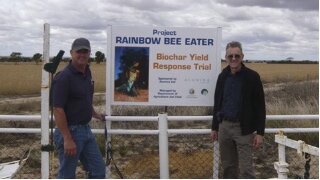 Stephen Davies, Western Australian Department of Agriculture & Food Peter Burgess, Project Rainbow Bee Eater Ian Stanley, Project Rainbow Bee Eater Syd Shea, Project Rainbow Bee Eater |
|
Abstract of Project/Research: Project Rainbow Bee Eater was initiated by Peter Burgess, Syd Shea and Ian Stanley in 2007 to investigate the feasibility of manufacturing and utilising biochar in a number of Australia's wheat production areas, using local crop and plantation waste from existing cleared farmland as feedstock. A prefeasibility study was undertaken to study: i) logistics of biomass collection and biochar delivery based on regional biochar ‘nodes’ ii) technologies capable of converting crop and plantation waste to biochar and electricity for sale to the local grid iii) multi year impacts to a wheat farm of closed loop biomass collection & biochar return iv) project economics and risks v) indirect impacts on the regions involved  Larger scale, practical demonstration and research have been limited by non-availability of affordable, large tonnage quantities of biochar of known quality and origins. The Rainbow Bee Eater team believed that larger scale, multi year field trials on a dryland farm with larger quantities of biochar of known quality and origins would contribute to the overall knowledge base. Larger scale, practical demonstration and research have been limited by non-availability of affordable, large tonnage quantities of biochar of known quality and origins. The Rainbow Bee Eater team believed that larger scale, multi year field trials on a dryland farm with larger quantities of biochar of known quality and origins would contribute to the overall knowledge base.Subsequently two biochar experiments comprising 160 plots 20m long and 1.8 m wide were established at Kalannie in 2008 to investigate the effect of biochar application on growth of dryland (rainfed) wheat. The experiments were implemented and managed by the Western Australian Department of Agriculture and Food with assistance from Ian, Clint and Travis Stanley. The aims of these experiments are to assess: 1. the value of biochar as a soil amendment; 2. the impact of biochar on the yield and quality of rainfed wheat. 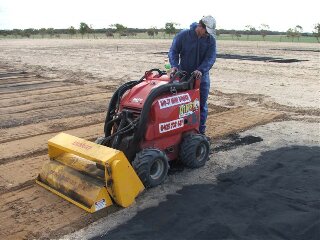 Biochar: The 2008 experiments used two types of biochar produced for Project Rainbow Bee Eater by Alterna Energy Pty Ltd, Johannesburg from South African wheat straw and by Ansac Pty Ltd, Bunbury, from Western Australian oil mallee residues. Approximately twenty five tonnes of biochar was manufactured. Future biochar will be locally manufactured in regional biochar nodes. Biochar process conditions were a continuous direct heated slow pyrolysis processes operated around 480C. |
|
Preliminary Results/Key Findings: The 2008 biochar experimental trials were conducted as part of the Project Rainbow Bee Eater prefeasibility study and provided valuable learning. The banded biochar experiment best represents the application method that farmers are likely to use. While there was no response to banded biochar in the first year of application the experiment will continue in 2009 and beyond to assess what benefits if any occur in later years. The site had good soil fertility for dryland wheat production and this may have limited any response to biochar as a nutrient source. 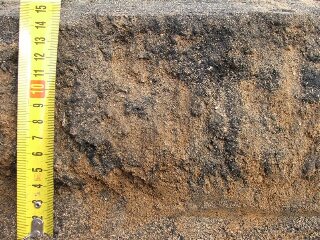 The incorporated biochar trial in which higher biochar rates were applied showed promising results. The incorporated biochar trial in which higher biochar rates were applied showed promising results.Cultivation tended to have a negative effect on crop growth at the half fertiliser rate and incorporation of biochar in the cultivated soil improved crop growth and increased both grain and protein yield. Development of the pyrolysis and dust free biochar incorporation equipment is continuing as part of Project Rainbow Bee Eater. Both experiments will be sown to wheat again in 2009 as we further develop our understanding of the longer term impacts to a wheat farm of closed loop biomass collection & biochar return. Evolution of grain yield and protein, weed population, chemical and fertilizer consumption, soil conditions and carbon sequestration are all of interest in this multi year study. |
Northern Poultry Bio-Waste: Testing & Trialing Soil Enhancement Co-Products
|
Research Institution/Department/Company: Nothern Poultry Cluster Ltd & Biochar-Energy Systems (Australia) Pty Ltd Project Funding Acknowledgment: Landcare Sustainable Practices Grants 2008-09 Project Schedule: Commenced 2009 - Ongoing Research Team: Russell Burnett, Biochar-Energy Systems (Australia) Pty Ltd Wayne Street, Northern Poultry Cluster Ltd. Peter Hazeldene, Hazeldene's Poultry Farms. Mike Cowie, Gourmet Poultry & Game. Dr Greg Underwood, Hyline/Broiler Breeders. Jeffe Bothe, City of Greater Bendigo. |
|
Abstract of Project/Research:
The project was designed to demonstrate the merits of biochar in cereal growing areas of Western Victoria. There were three sub-objectives in achieving this aim: i. To investigate and quantify the biological soil and agricultural improvent potential of biochar produced from processed recycled poultry waste. ii. To compare the performance of biochar against traditional fertiliser products. iii. To demonstrate the benefits of the field trial results to utilise waste products as part of a sustainable soil management sysem and in building new community, inter-industry and government agency collaborative arrangements.Biochar: Source: Biochar-Energy Systems (Australia) Pty Ltd. Feedstock: Poultry Litter Process: Continuous slow pyrolysis at 550oC |
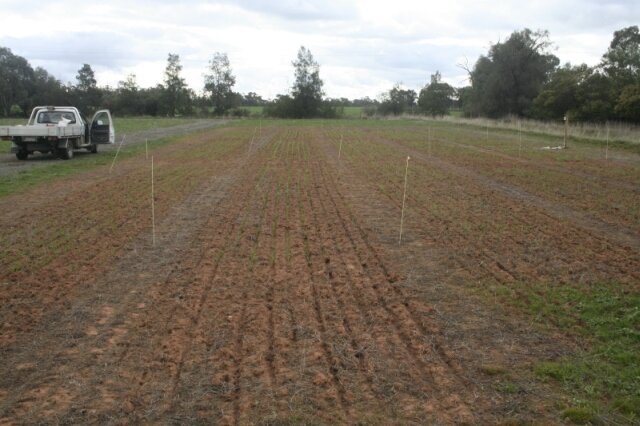 Elmore Field Days Plot Trial Site Preliminary Results/Key Findings: Project commenced in April 2009 with the first of 11 sites planted with wheat and biochar. Trial sites situated fom Midura and Barham (NSW) in the north to Ballarat in the south. Treatments are: i. DAP/MAP replacement with Biochar at 100kg/Ha & Wheat or Barley at 70-80kg/Ha. Controls sown with 70-80kg DAP or MAP/Ha & Wheat or Barley at 70-80kg/Ha. Trial plot size 2Ha per site. Conventional direct-drill air-seeder used to apply seed biochar or fertilizer, as per normal farmer sowing practice. ii. Plot trials with biochar applications of 1.0tonne, 2.5tonne & 5.0tonne with nil fertilizer. Controls with DAP at 80kg/Ha rate. At July 2009 we are very early into the first year. Crops sown in April are only at mid tillering stage (5-6 leaf) with the later sown plots at the pre-tillering stage(2nd leaf). At this stage for the biochar replacement of DAP/MAP at sowing trials, there is no discernable difference with controls. For the plot trials with heavier biochar applications, visual assessments vary from slightly more vigorous growth with some plots at 5tonne biochar rates, to some plots showing nitrogen stress at the 1.0 - 2.5tonne biochar rates. |
Add a project?
Do you have a biochar project underway in Australia or NZ and would like it included here? Please download and fill out and return the following form: Biochar Project Form
